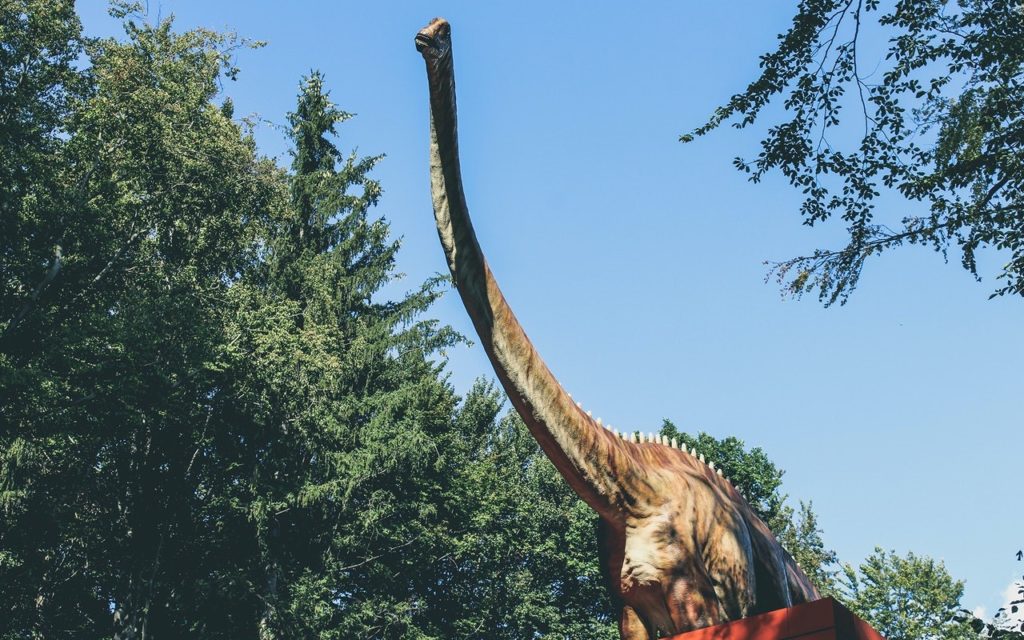
I learned this today. Dinosaurs were able to grow so big because they had hollow bones, could get more nutrition out of less food, and they didn’t need to chew their food.
The largest land animal today is the African elephant and they grow up to about 3m and weigh about 6 tons. The largest dinosaur was (probably) the Argentinosaurus, one of the sauropods, and it grew to be about 40m long and up to 100 tons in weight. The largest currently living animal is the blue whale, which can weigh up to 200 tons, but its weight is supported by the water. How could dinosaurs of such immense size survive? If an elephant was ten times larger it would collapse under its own weight.
The how and the why dinosaurs grew so big are different. The how seems to be pretty straightforward.
The first reason is that dinosaurs had hollow bones that contained lots of air sacs. Dinosaurs are related to birds, and they share a similar bone structure. All bones have a spongy structure in the center of them. This is called trabecular bone and it has a honeycomb structure. In mammals, the spaces inside the honeycomb are filled with bone marrow and blood vessels. The main job of the trabecular bone is to support the weight of the animal and to absorb stress. Bones that carry more weight and need to absorb more stress, such as our femur, have a lot more trabecular bone than, say, a finger bone.
Dinosaurs also had trabecular bone, but it differed from ours in a few ways. Firstly, it was suffused with air sacs. This helped the dinosaurs breathe more easily, but it also served to make the bones lighter. The second thing is that as dinosaurs get larger, their bones don’t increase in thickness. Rather, the density of the trabecular bone increases. This allows the bones to support far more weight without becoming a lot heavier. If an elephant grew to the size of a dinosaur, its bones would increase in thickness and become far too heavy for the animal to support.
The second reason dinosaurs could grow so big is the amount of food that the dinosaurs could consume. An elephant needs about 70,000 calories a day and it was long assumed that the larger dinosaurs would have to eat tons of food a day. This would have been extremely difficult to find and would, if anything, have been an evolutionary reason why dinosaurs couldn’t grow so big. However, recent research has demonstrated that a sauropod, (one of the 30 ton dinosaurs) would only need to eat about 110kg of food a day. This is a surprisingly small amount of food and is even less than an elephant eats. The reason for this is that the levels of carbon dioxide in the atmosphere were higher during the time of the dinosaurs than they are now, which would have allowed the foliage to photosynthesize more and it would have had more nutritional energy in it.
The size of their heads was also an important reason that dinosaurs could grow so big. An elephant’s head contains about 10% of its body weight. A dinosaur’s head was a fraction of this. The dinosaurs evolved to not need large teeth and strong jaws because they didn’t chew their food. They had sharp incisors to rip foliage from trees, which they swallowed whole to be digested in their enormous stomachs. Not having teeth and the strong chewing muscles other plant eating animals had allowed them to have extremely small heads for their body size, allowing them to grow much larger. A large head would have been an enormous weight to bear. A small head also means a smaller brain, which reduces the body’s calorific requirement.
The why they grew so big is a little less well understood. There are some theories. It could have been an evolutionary race. Herbivores that are larger than the carnivores that prey on them are usually safe. That is, until the carnivores then increase in size. Larger carnivores might have led to an increase in size of the herbivores and so on and so on until they were all enormous. The sauropods were generally safe from all predators and it makes it likely that a lot of the large predators, like T-rex, were actually scavengers.
Another theory is that their size was because dinosaurs were cold-blooded. The larger the surface area of a cold-blooded animal, the easier it is to balance its heat. Large animals warm up slowly and cool down slowly, giving a fairly constant average body temperature.
Their diet could also have been a factor. The higher levels of carbon dioxide in the air made the plant life more nutritious and gave higher energy value per kg eaten. Animals could grow bigger without eating massive amounts of food.
It is also possible that the higher levels of carbon dioxide also made for much taller trees as well. Being bigger would have given dinosaurs the same competitive advantage that giraffes have over other plant eating animals.
So, dinosaurs could support their enormous size because their bones were strong, light, and hollow. Also, they could get far more nutrition out of their food and they didn’t need to chew it. And this is what I learned today.
Photo by Creative Vix from Pexels
Sources:
https://www.sciencefocus.com/nature/why-were-dinosaurs-so-big/
https://www.usgs.gov/faqs/why-did-some-dinosaurs-grow-so-big
https://www.thoughtco.com/why-were-dinosaurs-so-big-1092128
https://en.wikipedia.org/wiki/Elephant
https://en.wikipedia.org/wiki/Dinosaur_size
https://en.wikipedia.org/wiki/Argentinosaurus
https://en.wikipedia.org/wiki/Blue_whale
https://www.sciencedaily.com/releases/2020/08/200820143232.htm
https://www.britannica.com/science/cancellous-bone
